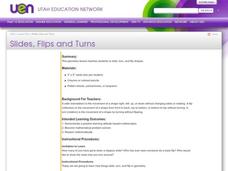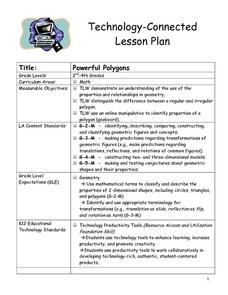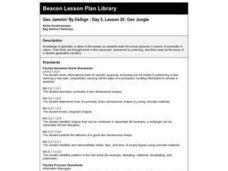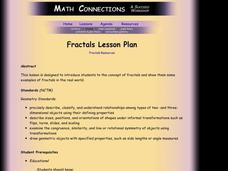Curated OER
Slides, Flips and Turns
Third graders are introduced to the meanings of the concepts slides, turns, and flips in how they relate to Geometry. As a class, they use their bodies to demonstrate how each term should look like. To end the lesson, they apply the...
Curated OER
Flips, Sides and Turns: Exploring Transformations
Students use an online dictionaries to define key geometric terms. They explore several websites to help them differentiate the terms reflections, translations and rotations as they apply to geometry and then complete an assessment...
Curated OER
Slides, Flips and Turns
Third graders slide, turn, and flip their bodies to explain sliding, turning, and flipping geometric shapes.
Curated OER
Powerful Polygons
Students scan the classroom to find different common shapes. They listen as the teacher defines polygon and regular polygon. The teacher demonstrates regular polygons via the Internet and the "Math is Fun" web site. Students go outside...
Curated OER
Geo Jammin' By DeSign - Day 5, Lesson 25: Geo Jungle
Students search the school grounds for examples of symmetry in nature. They bring examples back to the classroom and write about them.
Curated OER
Tessellations
Students identify shapes that will tessellate. They construct a tessellation using transformations. Students identify transformations in tessellations. They identify applications of transformations such as tiling and fabric design.
Curated OER
Fractals
Young scholars explore the concept of fractals. In this fractal instructional activity, students use applets to explore Koch's Snowflake, Sierpinski's Triangle, and other fractals. Young scholars develop these concepts through...
Curated OER
Tetrominoes Cover-Up
Third graders are given square tiles and participate in a demonstration on how to arrange them. Using the tiles, they work with a partner to discover how many two-dimensional tetrominoes they can create. To end the instructional...









